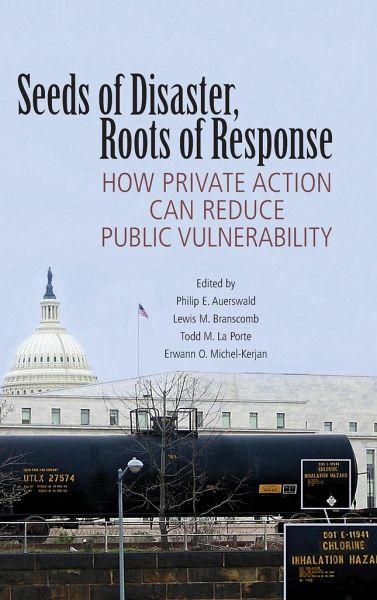Philip E. Auerswald / Lewis M. Branscomb / Todd M. La Porte / Erwann O. Michel-Kerjan (eds.)
Gebundenes Buch
Seeds of Disaster, Roots of Response
Versandkostenfrei!
Versandfertig in 1-2 Wochen
Weitere Ausgaben:

PAYBACK Punkte
75 °P sammeln!




Seeds of Disaster, Roots of Response is the first systematic attempt to understand how private decisions affect public vulnerability.
Philip E. Auerswald, PhD (editor) is Director of the Center for Science and Technology Policy and an Assistant Professor at the School of Public Policy, George Mason University. Professor Auerswald's work focuses on linked processes of technological and organizational change in the contexts of policy, economics, and strategy. He is the founding co-editor of Innovations: Technology, Governance, Globalization, a quarterly journal from MIT Press about people using technology to address global challenges. He was previously a Research Fellow and Assistant Director of the Science, Technology, and Public Policy Program at the Kennedy School of Government, Harvard University. His published work has addressed entrepreneurial finance, organizational learning, industry dynamics, and innovation policy. He has been a consultant for the National Academies of Science, the National Institute of Standards and Technology, and the Commonwealth of Massachusetts. He holds a PhD in economics from the University of Washington and a BA (political science) from Yale University.
Lewis M. Branscomb, PhD is Professor of Public Policy and Corporate Management, emeritus, at Harvard University's Kennedy School of Government. He also holds faculty appointments at the University of California San Diego. Branscomb was the co-chairman of the project of the National Academies of Science and of Engineering and the Institute of Medicine, which authored the 2002 report Making the Nation Safer: Science and Technology for Countering Terrorism.
Todd M. La Porte, PhD is an associate professor at George Mason University. He was a member of the Faculty of Technology, Policy and Management at the Delft University of Technology in The Netherlands. He also served for six years as an analyst in the information technology and the international security programs at the Office of Technology Assessment (OTA), a research office of the U.S. Congress.
Erwann O. Michel-Kerjan, PhD is Managing Director of the Center for Risk Management and Decision Processes at the University of Pennsylvania's Wharton School. His work focuses on financing extreme events, with a prime interest in the creation and implementation of private-public collaboration among top decision makers of organizations, or countries, in America and in Europe. He is a member of the Global Risk Network of the World Economic Forum.
Lewis M. Branscomb, PhD is Professor of Public Policy and Corporate Management, emeritus, at Harvard University's Kennedy School of Government. He also holds faculty appointments at the University of California San Diego. Branscomb was the co-chairman of the project of the National Academies of Science and of Engineering and the Institute of Medicine, which authored the 2002 report Making the Nation Safer: Science and Technology for Countering Terrorism.
Todd M. La Porte, PhD is an associate professor at George Mason University. He was a member of the Faculty of Technology, Policy and Management at the Delft University of Technology in The Netherlands. He also served for six years as an analyst in the information technology and the international security programs at the Office of Technology Assessment (OTA), a research office of the U.S. Congress.
Erwann O. Michel-Kerjan, PhD is Managing Director of the Center for Risk Management and Decision Processes at the University of Pennsylvania's Wharton School. His work focuses on financing extreme events, with a prime interest in the creation and implementation of private-public collaboration among top decision makers of organizations, or countries, in America and in Europe. He is a member of the Global Risk Network of the World Economic Forum.
Produktdetails
- Verlag: Cambridge University Press
- Seitenzahl: 578
- Erscheinungstermin: 23. November 2006
- Englisch
- Abmessung: 240mm x 161mm x 35mm
- Gewicht: 1024g
- ISBN-13: 9780521857963
- ISBN-10: 0521857961
- Artikelnr.: 22064574
Herstellerkennzeichnung
Libri GmbH
Europaallee 1
36244 Bad Hersfeld
gpsr@libri.de
Für dieses Produkt wurde noch keine Bewertung abgegeben. Wir würden uns sehr freuen, wenn du die erste Bewertung schreibst!
Eine Bewertung schreiben
Eine Bewertung schreiben
Andere Kunden interessierten sich für














